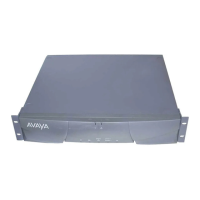ATM-SGRP (ATM Signaling Group)
Issue 1 May 2002
8-257555-233-143
Table 8-106. Descriptions and repair recommendations (Error Types 3840-3928)
Error
Code Description Recommendation
3842 A request has been made
to use a transit network or
common carrier that cannot
be accessed.
From the circuit pack and port number (in the Aux Data
field), determine the trunk group against which the error
was reported.
1. Check every routing pattern containing this trunk
group for validity of interexchange carriers requested
(IXC field).
3846 The far-end switch has
indicated that the B channel
(trunk) is not acceptable for
use in the call for which it
was requested.
This could indicate
■ an administration problem (for example, the local
switch and the far-end switch have different B
channels administered)
■ a normal race condition (for example, the local switch
has requested use of a B channel that the far-end
switch had just reserved for use on another call).
1. From the circuit pack and port number (in the Aux
Data field), determine the trunk group against which
the error was reported.
2. Issue the status trunk command for the indicated
trunk.
3. Refer to Table 8-67 on page 8-169 in ‘‘ATM-BCH
(ATM B-Channel Trunk)’’ for recovery suggestions.
3858 Similar to Error Type 1.
The switch sent an ISDN
message to the far-end
switch or terminal adapter
that did not respond in the
allotted time.
1. Check for alarms and errors against link components
2. Check out other errors against ‘‘ATM-SGRP (ATM
Signaling Group)’’, ‘‘ATM-TRK (Circuit Emulation
Service Circuit Pack)’’, and other hardware
components on the link.
3878 The far-end switch has
indicated that the network is
not functioning correctly
and that the condition may
last a relatively long period
of time (for example,
immediately re-attempting
the call may not be
successful).
1. From the circuit pack and port number (in the Aux
Data field, determine the trunk group against which
the error was reported.
2. Consult with the network provider to determine the
nature and expected duration of the out of service
condition.
3. Consider modifying every routing pattern containing
this trunk group, to route calls around the network that
is out of service.
Continued on next page

